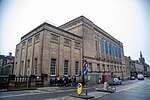The Court of Session is the supreme civil court of Scotland and constitutes part of the College of Justice; the supreme criminal court of Scotland is the High Court of Justiciary. The Court of Session sits in Parliament House in Edinburgh and is both a trial court and a court of appeal. Decisions of the court can be appealed to the Supreme Court of the United Kingdom, with the permission of either the Inner House or the Supreme Court. The Court of Session and the local sheriff courts of Scotland have concurrent jurisdiction for all cases with a monetary value in excess of £100,000; the plaintiff is given first choice of court. However, the majority of complex, important, or high value cases are brought in the Court of Session. Cases can be remitted to the Court of Session from the sheriff courts, including the Sheriff Personal Injury Court, at the request of the presiding sheriff. Legal aid, administered by the Scottish Legal Aid Board, is available to persons with little disposable income for cases in the Court of Session.
The court is a unitary collegiate court, with all judges other than the Lord President of the Court of Session and the Lord Justice Clerk holding the same rank and title—Senator of the College of Justice and also Lord or Lady of Council and Session. The Lord President is chief justice of the court, and also head of the judiciary of Scotland; the Lord Justice Clerk is his deputy. There are 35 senators, in addition to a number of temporary judges; these temporary judges are typically serving sheriffs and sheriffs principal, or advocates in private practice. The senators sit also in the High Court of Justiciary, where the Lord President is called the Lord Justice General, and senators are known as Lords Commissioners of Justiciary.
The court is divided into the Inner House of twelve senators, which is primarily an appeal court, and the Outer House, which is primarily a court of first instance. The Inner House is further divided into two divisions of six senators: the first division is presided over by the Lord President, and the second division is presided over by the Lord Justice Clerk. Cases in the Inner House are normally heard before a bench of three senators, though more complex or important cases are presided over by five senators. On very rare occasions the whole Inner House has presided over a case. Cases in the Outer House are heard by a single senator sitting as a Lord Ordinary, occasionally with a jury of twelve.
The court is administered by the Scottish Courts and Tribunals Service, and the most senior clerk of court is the Principal Clerk of Session and Justiciary; the Principal Clerk is responsible for all court staff, and is also responsible for the administration of the High Court of Justiciary.
The court was established in 1532 by an Act of the Parliament of Scotland, and was initially presided over by the Lord Chancellor of Scotland and had equal numbers of clergy and laity. The judges were all appointed from the King's Council.
As of May 2017, the Lord President was Lord Carloway, who was appointed on 19 December 2015, and the Lord Justice Clerk was Lady Dorrian, who was appointed on 13 April 2016.











